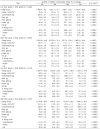Abstract
Purpose
Methods
Results
Conclusion
Figures and Tables
 | Fig. 1Distribution of dietary fiber intake (A) and dietary fiber intake according to dietary carbohydrate (B). All models were adjusted for age, body mass index, education, house income, physical activity, smoking, alcohol consumption, energy intake, and appropriate sampling weight was applied for the complex sampling design. p for trend were obtained from linear regression analysis. |
 | Fig. 2The odds ratio and 95% confidence intervals of metabolic syndrome according to the quintile of dietary fiber intake by sex. All models were adjusted for age, body mass index, education, house income, physical activity, smoking, alcohol consumption, energy intake, and appropriate sampling weight was applied for the complex sampling design. Odds ratios were obtained from multiple logistic regression model adjusted for age, body mass index, education, household income, physical activity, smoking, alcohol consumption, energy intake. p for trend were obtained from the same model as estimation of ORs by using the median dietary fiber intake of each quintile as the independent variable. |
Table 1
General characteristics of study participants by sex

1) The numbers of missing values were respectively 522 (men, education level), 25 (men, household income), 263 men, alcohol consumption), 268 (men, smoking), 534 (men, physical activity), 548 (women, education level), 34 (women, household income), 264 (women, alcohol consumption), 268 (women, smoking), and 560 (women, physical activity)
2) Alcohol consumption: “none”, no consumption of any type of alcoholic beverage, “moderate”, no more than 2 drinks per day for men and 1 drink per day for women, “high”, more than 2 drinks per day for men and 1 drink per day for women
3) Smoking: “never”, never smoked cigarettes or smoked < 100 cigarettes in lifetime, “former”, smoked ≥ 100 cigarettes in lifetime but current non-smoker, “current”, smoked ≥ 100 cigarettes in lifetime and current smoker
4) Physical activity: “yes”, performed vigorous-intensity activities for at least 75 min, or moderate-intensity activities for at least 150 min, or an equivalent combination of moderate- and vigorous-intensity activity during a typical week
5) p-values were obtained from chi-square tests for categorical variables.
Table 2
Energy and macronutrient intakes according to quartile of dietary carbohydrate intake by sex in low or high fiber group1)2)

1) All values are adjusted mean ± standard error after adjusting for age, body mass index, education, household income, physical activity, smoking, alcohol consumption and total energy intake.
2) The complex sampling design parameters of the Korea National Health and Nutrition Examination Survey were used.
3) EER, Estimated energy requirement
4) p for trend values were calculated using a general linear regression.
Table 3
Multivariate odds ratios for metabolic disease according to quartile of dietary carbohydrate intake among men in low or high fiber group1)2)

1) The complex sampling design parameters of the Korea National Health and Nutrition Examination Survey were used.
2) Adjusted for age, body mass index (except the model of waist circumference), education, household income, physical activity, smoking, alcohol consumption and total energy intake.
3) Atherogenic dyslipidemia comprises reduced HDL-C and increased triglycerides.
4) p for trend values were calculated using a general linear regression.
Table 4
Multivariate odds ratios for metabolic disease according to quartile of dietary carbohydrate intake among women in low or high fiber group1)2)

1) The complex sampling design parameters of the Korea National Health and Nutrition Examination Survey were used.
2) Adjusted for age, body mass index (except the model of waist circumference), education, household income, physical activity, smoking, alcohol consumption and total energy intake.
3) Atherogenic dyslipidemia comprises reduced HDL-C and increased triglycerides.
4) p for trend values were calculated using a general linear regression.




 PDF
PDF ePub
ePub Citation
Citation Print
Print



 XML Download
XML Download